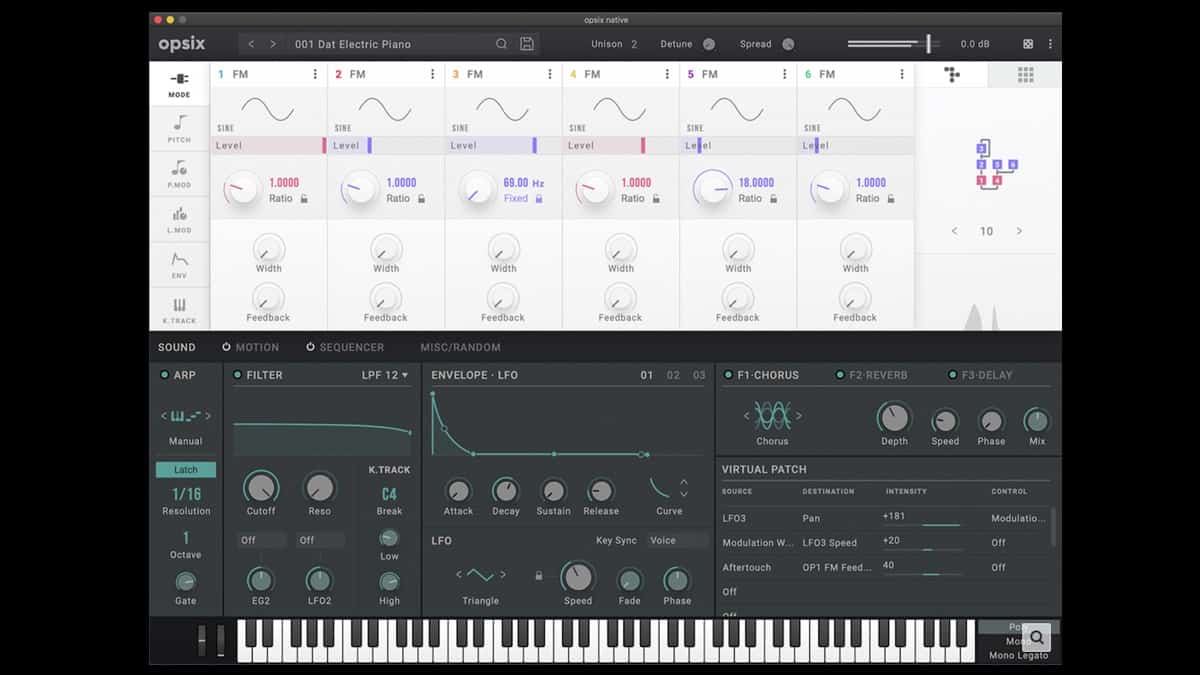In This Issue
Korg Opsix Native – the Synth and Software Review

If you think this is just a DX7 clone, Marty Cutler advises you to think again… and again.
Yamaha’s DX7 was one of the top selling synthesizers of all time. It had crisp, detailed, digital FM sounds that provided welcome contrast to the prevailing tones of analog, subtractive synthesizers when it was introduced in 1983.
Frequency Modulation synthesis in the DX7 employed 32 algorithms, which were arrangements of its six sine wave “oscillators” (Yamaha called them Operators). They were divided into Carriers and Modulators. Modulators, when tuned to different frequencies, affected the output tone of the Carriers.
There were many other parameters influencing the final sound, but suffice it to say that programming a DX7 could be complicated.
Conventional wisdom holds that the 32-algorithm limitation of the DX7 was a result of Yamaha’s determination that anything more would be superfluous. Since then, of course, we’ve seen a number of synths with more algorithms. They also use filters and a raft of digitally generated waveforms that extend well beyond just sine waves.

Korg’s Opsix Native is one such synth (a software version of their hardware version, reviewed here). But if you think it’s simply a DX7 with more waveforms and filters – despite the somewhat similar color scheme – think again.
Also, take a listen to some of these quick examples:
One basic factor that distinguishes Opsix from other FM synths is its unique signal flow. Most FM synths use a conventional formula of carriers and modulators, and then feed the resulting sound to effects, filters, and the like. Opsix can change an Operator’s “mode” to generate a number of DSP processes within the operators.
The results can go pretty far afield of conventional FM algorithms. Add a sequencer for note patterns, another for animation, plus an arpeggiator, and you have some serious sound-wrangling tools.
Algorithm method. You select a block and then click on the magnifying glass icon to assign it one of 40 algorithms.
If you don’t find what you’re looking for, plot your own algorithm using the graphical editor.
The first 32 algorithms are the ones in the original DX7. But unlike in the hardware Opsix, you can’t import DX7 patches. Their envelope generators are different.
(For that, Dexed is a free software clone of the original DX7 that does load the original patches.)
Modes. Each of the Opsix’ six operators has a Mode to process it, modifying the waveform. (You can mute or bypass operators to focus on individual or multiple components; I’d appreciate a solo button as well for a speedier workflow.)
The Modes are: Ring Mod; Filter; Filter FM; Wavefolder; Effect; Bypass; and Mute, as well as standard FM, which includes a healthy supply of additional waveforms beyond the default sine wave (Fig. 5).
Selecting a Mode other than the standard FM carrier or modulator has a profound and often unpredictable effect on the patch. For example, ring modulation or Filter FM on a carrier with a complex waveform will sound wildly different from the same functions on a modulator.
Add Opsix’s Virtual Patch feature – an additional modulation matrix with a comprehensive menu of controls, sources, and destinations – and the sonic and expressive possibilities become truly vast.
And? Programming with FM synthesis is somewhat abstract compared to most subtractive synth techniques. Thankfully, Korg provides a handful of templates to start with. If you have a general idea of how carriers and modulators work, tweaking the templates or any of the other presets will yield useful results.
Above all, RTFM! It is informative, well-written, and it will provide a helpful path to FM sound-design enlightenment.
Opsix is an intriguing new wrinkle in FM synthesis. Sounds range from blatantly digital to familiar FM stalwarts infused with analog-sounding warmth and heat to wholly original creations.
If my enthusiasm for Opsix doesn’t convince you, download a demo version and take it for a spin.
Price: $199
Click here for the Korg product page




















